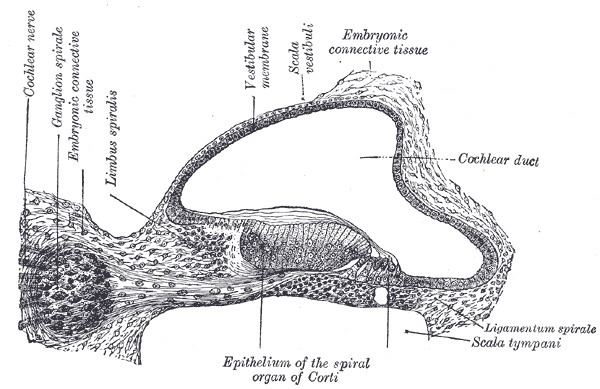TA A15.3.03.125 FMA 53445 | MeSH A08.340.390.800 TH H3.11.09.3.04068 | |
 | ||
The spiral (cochlear) ganglion is the group of nerve cells that serve the sense of hearing by sending a representation of sound from the cochlea to the brain. The cell bodies of the spiral ganglion neurons are found in the modiolus, the conical shaped central axis in the cochlea.
Contents
Structure
Neurons whose cell bodies lie in the spiral ganglion are strung along the bony core of the cochlea, and send fibers (axons) into the central nervous system (CNS). These bipolar neurons are the first neurons in the auditory system to fire an action potential, and supply all of the brain's auditory input. Their dendrites make synaptic contact with the base of hair cells, and their axons are bundled together to form the auditory portion of eighth cranial nerve. The number of neurons in the spiral ganglion is estimated to be about 35,000–50,000.
Two apparent subtypes of spiral ganglion cells exist. Type I spiral ganglion cells comprise the vast majority of spiral ganglion cells (90-95% in cats and 88% in humans), and exclusively innervate the inner hair cells. They are myelinated, bipolar neurons. Type II spiral ganglion cells make up the remainder. In contrast to Type I cells, they are unipolar and unmyelinated in most mammals. They innervate the outer hair cells, with each Type II neuron sampling many (15-20) outer hair cells. In addition, outer hair cells form reciprocal synapses onto Type II spiral ganglion cells, suggesting that the Type II cells have both afferent and efferent roles.
Development
The rudiment of the acoustic nerve appears about the end of the third week as a group of ganglion cells closely applied to the cephalic edge of the auditory vesicle. The ganglion gradually splits into two parts, the vestibular ganglion and the spiral ganglion. The fibers connecting the spiral ganglion with the central nervous system form the cochlear nerve.
